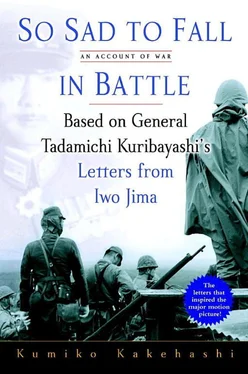At some point Kuribayashi was seriously wounded in his right thigh, but still pushed on, carried on the back of a first sergeant attached to the headquarters. He is thought to have died either from loss of blood or to have taken his own life with a pistol shot. No one survived who witnessed the last moments of this commander who fought side by side with his men until his own death.
THE MORNING KURIBAYASHI DIED, the 77th Infantry Division of the U.S. Army landed on the Kerama Islands of Okinawa, 1,380 kilometers away from Iwo Jima. The civilians were drawn into the battle, and this marked the start of the Battle of Okinawa, which eventually produced so many—some say one hundred thousand—civilian casualties.
YOSHII WAS FORTY YEARS OLD WHEN HER HUSBAND LOST HIS LIFE on Iwo Jima. A housewife ever since her marriage at the age of nineteen, she was suddenly responsible for earning the family livelihood while also taking care of her three children.
Takako, Kuribayashi’s second daughter, can remember her mother out in the streets of Nagano just after the war, where her family home was located, selling dried cuttlefish she’d somehow managed to get her hands on. After the family returned to Tokyo, Yoshii rented a small place near Nagano station, where she sold wooden clogs and other footwear.
She later worked as an insurance saleswoman, and eventually got a job as live-in matron at the staff dormitory of a spinning company in Tokyo’s Setagaya Ward. Takako lived in the dormitory building with her mother until leaving high school. The two women then lived in a one-room apartment, sharing cooking and toilet facilities with the other residents. When relatives of soldiers who had died on Iwo Jima visited them to borrow money, Yoshii would hand over as much as she could with an apology: “I’m afraid this is all that we’ve got….”
“My mother had been brought up as a lady, and even after getting married she had been taken care of by my father. She had never worked in her life before, but she still managed to raise us during the terrible times after the war by doing things like selling cuttlefish out on the street. And more than that, she sent not just my elder brother, but me, a girl, to university.”
Kuribayashi never ordered his wife to live as a proper soldier’s wife, taking care not to soil her husband’s good name after he was gone. Indeed, he seems to have said quite the opposite in his letters from Iwo Jima. In one dated September 4, 1944, he tells her that he’s depending on her to bring up the children and continues: “From now on, don’t worry about things like keeping up appearances or what other people say about you. What’s important is for you to believe in yourself and go your own way.”
A lieutenant general, Kuribayashi was posthumously promoted to full general in recognition of his heroic defense of Iwo Jima. Yoshii was therefore supposed to live with the pride proper to the wife of a general. But in her case that did not mean guarding the family name and passing the exploits of her husband down to her children and her children’s children. That was not what her husband wanted from her.
Other people and appearances don’t matter, believe in yourself and live your way. Confront harsh reality head-on, and be strong together with your children. That was what Kuribayashi asked his wife to do when he knew that he would no longer be able to take care of his family. And Yoshii rose to the challenge, living through the postwar years with a strength that had nothing to do with worldly appearances or the opinions of other people.
One day after the children had grown up and left home, and she was able to live a less fraught existence, Yoshii had a dream. Her husband, whom she knew to be dead, stood grinning in the entryway of their house dressed in his army uniform. When she appeared startled, he said gently, “I just got back now.”
Ah, she thought, so you did come back to me after all. Happiness flooded her heart—and then she woke up. Even after she realized that it was a dream, the joy remained undimmed. Her husband had looked genuinely happy.
Very soon after that came the news that, after twenty-three years, the United States would be returning the Ogasawara Islands to Japan.
—
I VISITED MATSUSHIRO-MACHI, Kuribayashi’s hometown in Nagano, in the early summer of 2004.
The erstwhile castle town of Sanada Jûmangoku, Matsushiro-Machi was also the birthplace of Sakuma Shôzan, a leading progressive from the last years of the Tokugawa regime. The house where Kuribayashi was born is located in a quiet fold of a hill a little to the south of the center near the historic sights of Sanada’s residence and the Matsushiro Civil and Military School. As you walk up a gentle incline, the first thing you see is an old stone storehouse, then, beyond that, there stands an old two-story house with a tiled roof and white plaster walls. The house dates from the early Showa period, and the garden is full of white and pink peonies.
I was welcomed by Kuribayashi Naotaka, the present head of the family. Naotaka is the grandson of Kuribayashi’s elder brother, Yoshima. He was born in 1945, after Kuribayashi’s death, and is the principal of a junior high school.
The Kuribayashis are an old family. They have lived here since the Warring States period (1467–1568), when they were “country samurai” administering a barrier station for the Sanada clan. A country samurai is a samurai who does not move his abode to the castle town of his lord, but stays and farms in his own home place.
In the Tokugawa period (1600–1868), the Kuribayashis became clansmen of the Matsushiro clan, and in the Meiji period (1868–1912), they invested in the silk-reeling industry and the banking business, but failed in both due to “samurai business methods” (an aristocratic tendency to regard commerce as beneath one). Their house burned to the ground in both 1868 and 1881. In 1891 his parents were working hard to rebuild the place when Kuribayashi was born.
Yoshima’s eldest son Sunao wrote an unpublished essay about his uncle’s youth. Entitled “The Young Days of Kuribayashi Tadamichi,” the handwritten manuscript is preserved in the house. In it we learn that Kuribayashi’s father, Tsurujirô, engaged in the lumber and civil engineering businesses, while his mother, Moto, ran the farm with the servants. The parents were always busy, and from an early age the children used to help with domestic tasks like scrubbing the corridors and taking care of the garden. Despite being born into a “good” family in the provinces, Kuribayashi’s upbringing was simple and hardworking, and had nothing to do with luxury.
Kuribayashi progressed from Matsushiro Higher Elementary School to Nagano Middle School (currently Nagano High School). His grades were excellent and his English was particularly good—he is even said to have dreamed of becoming a roving foreign correspondent. According to anecdote, while on Iwo Jima he told the reporter Shishikura Tsunetaka that he had thought about becoming a journalist himself. And indeed, he sat the entrance examination not just for the Military Academy, but also sat and passed that for Shanhai Tôa Dôbun Shoin, a prestigious college for Japanese students in Shanghai, China. Kuribayashi was unsure which to choose, but finally decided to go to the Military Academy on the advice of his teacher.
After that he took the typical path of the elite officer, attending the Army War College and going abroad to study. But he never worked in the Imperial General Headquarters, never had any involvement with politics, and was not interested in the jockeying for position that went on between the different army factions.
His progress up the ranks was not especially fast for someone who had been honored with a saber from the emperor on graduation, and his appointments to major general and lieutenant general were both a good six months behind his fastest contemporaries at college. His career was surprisingly unglamorous—he spent a long time in a post where he was responsible for the army’s cavalry horses—and nothing really stands out until he was appointed commander in chief on Iwo Jima.
Читать дальше












